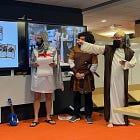An epic quest in career development (Part 2)
Play your cards right, empower your team, and unlock new levels of career success through the power of gamification!
In Part 1, we transformed the routine process of career development into an epic adventure by reimagining professional growth as a quest filled with challenges, rewards, and a touch of Dungeons & Dragons magic.
In Part 2, we take this a step further and simulate the job of an IT Architect as an interactive card game. After all, why not have fun with it?
Stick around until the end for the online adventure game version!
The Practice: A Card Game
The Practice: A Card Game simulates the dynamic experience of working in a team of IT Architects within a typical organisation. Players take on roles—Solutions, Domain, and Enterprise Architects, coordinated by Architecture Leaders—to collaborate strategically, combining their specialised skills to deliver successful Outcomes.
Achieve Outcomes by assembling all four role types, reflecting realistic teamwork, from creating designs and establishing guardrails to defining roadmaps and visionary leadership. The team or player that most effectively navigates collaboration and resource management to collect the most Outcomes wins the game!
Game Mechanics
Objective
The main goal is to deliver Outcomes. An Outcome is achieved once one of each Action card type is placed on the board:
Red (Solutions Architect)
Green (Domain Architect)
Blue (Enterprise Architect)
Gold (Architecture Leader)
This structure promotes teamwork and strategic planning, simulating real-world scenarios where different job roles must collaborate to achieve organizational objectives.
Setup
Shuffle the decks separately and place them in the center. Each player draws 7 cards from a combined deck of all Action and Resource cards.
Gameplay
Players take turns drawing cards, then playing Action and Resource cards.
Draw phase: Player takes 1 card from the pile.
Play phase: Player can place an Action card, and as many Resource cards as needed (based on Action card cost). Action cards are placed in front of the player while Resource cards are placed in the discard pile
The round continues to the next player.
Each player aims to put down one of each card type (Red, Green, Blue, Gold) to achieve an Outcome.
Once a player achieves an Outcome, they collect a star token.
Teamwork bonus
Assisted Play: When it's your turn to play Action and Resource cards, you may choose to add it to another player's hand instead of your own. Each player may contribute up to 1 Action card and up to 2 Resource cards per turn.
Immediate Reward: For each card contributed to another player's hand, you immediately draw two new cards.
Team Benefit: The contributed card counts toward the recipient’s progress in completing their Outcome.
This rule encourages cooperative play by allowing players to support one another, mirroring the collaborative nature of IT architectural teams within organizations.
Winning
A round ends when a player achieves an Outcome (collects all 4 colored tokens: Vision, Roadmap, Guardrail, and Design). All un-spent cards for that round are added to the discard pile.
Play as many rounds as desired, and the player with the most star tokens at the end wins.
Action Cards
Red (Solutions Architect)
Cost: 1
Function: Creates Designs.
Card Examples:
Rapid Design: Allows the player to draw two extra cards.
Efficient Blueprint: Reduces the cost of the next Domain Architect card by 1.
Green (Domain Architect)
Cost: 2
Function: Establishes Guardrails.
Card Examples:
Sturdy Guardrail: Players can't be affected by negative Magical items/buffs for one turn.
Scalable Blueprint: Allows the player to retrieve a discarded Solution Architect card.
Blue (Enterprise Architect)
Cost: 3
Function: Defines Strategies and Roadmaps.
Card Examples:
Efficient Strategy: Reduces the cost of the next Architecture Leader card by 1.
Long-Term Roadmap: Grants an extra turn.
Gold (Architecture Leader)
Cost 4
Function: Sets the Vision, develops People and Practice
Card Examples:
Clear Vision: Protects all your in-play cards from negative effects for one turn.
Innovative Directive: Swap a card with another player.
Motivational Speech: Players can play an additional card this turn.
Skill Workshop: Upgrade a card, reducing its resource cost by 1.
Bonus: Online game
What would an adventure game look like that where Monkey Island, Office Space, and Dungeons and Dragons had a baby?
On your first day at The Agency for Bureaucratic Process, use your IT architecture skills and magic to tackle challenges, office politics, and printer issues amidst a transformative chaos. I present:
Architects of the Digital Realm
Find out how I made the game on GitHub.
Stay tuned for part 3 where we expand on the idea of quests for career development, where we ask the question what if all competencies, skills badges, formal qualifications, and codified experiences were digital verifiable credentials that belong to individuals?












